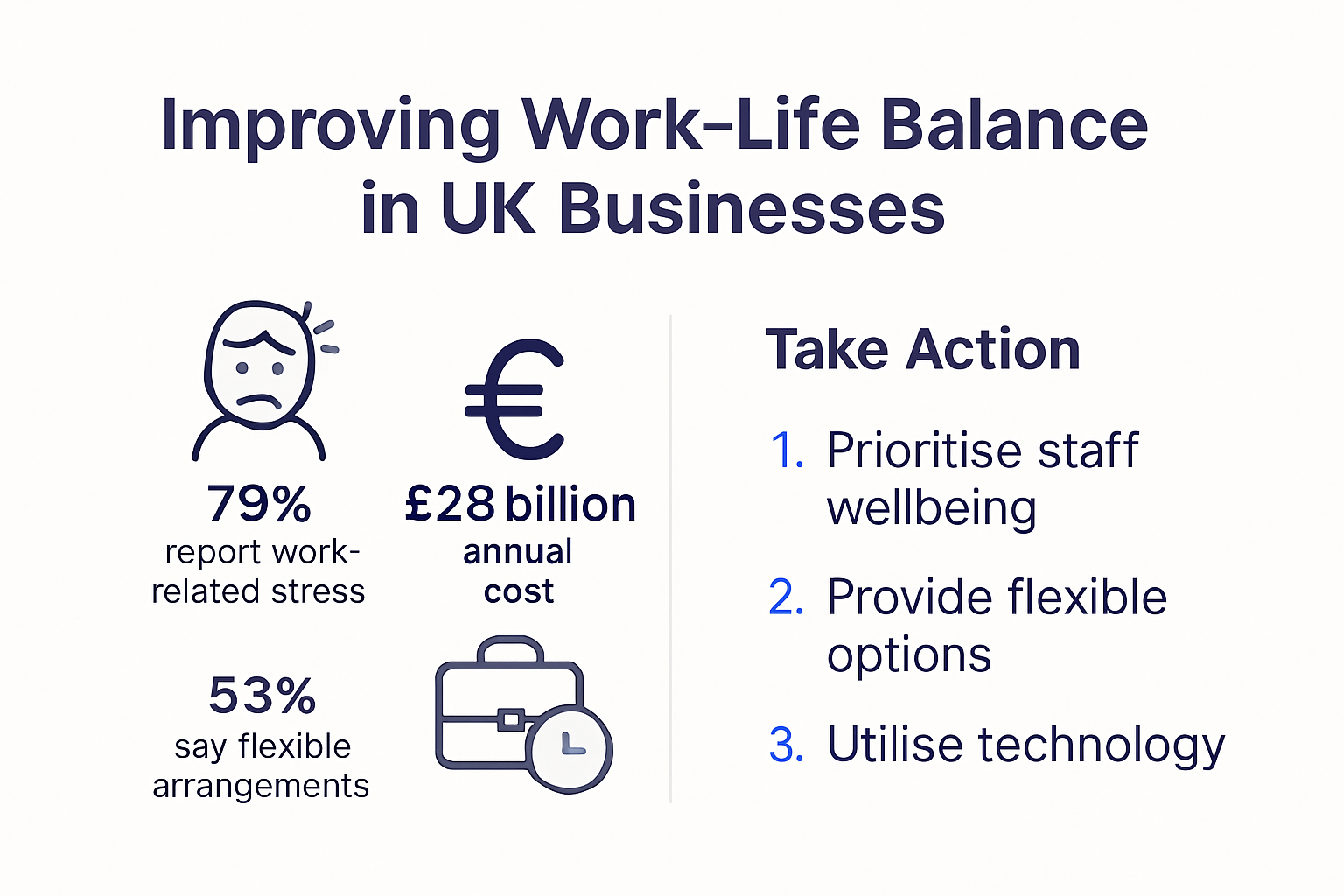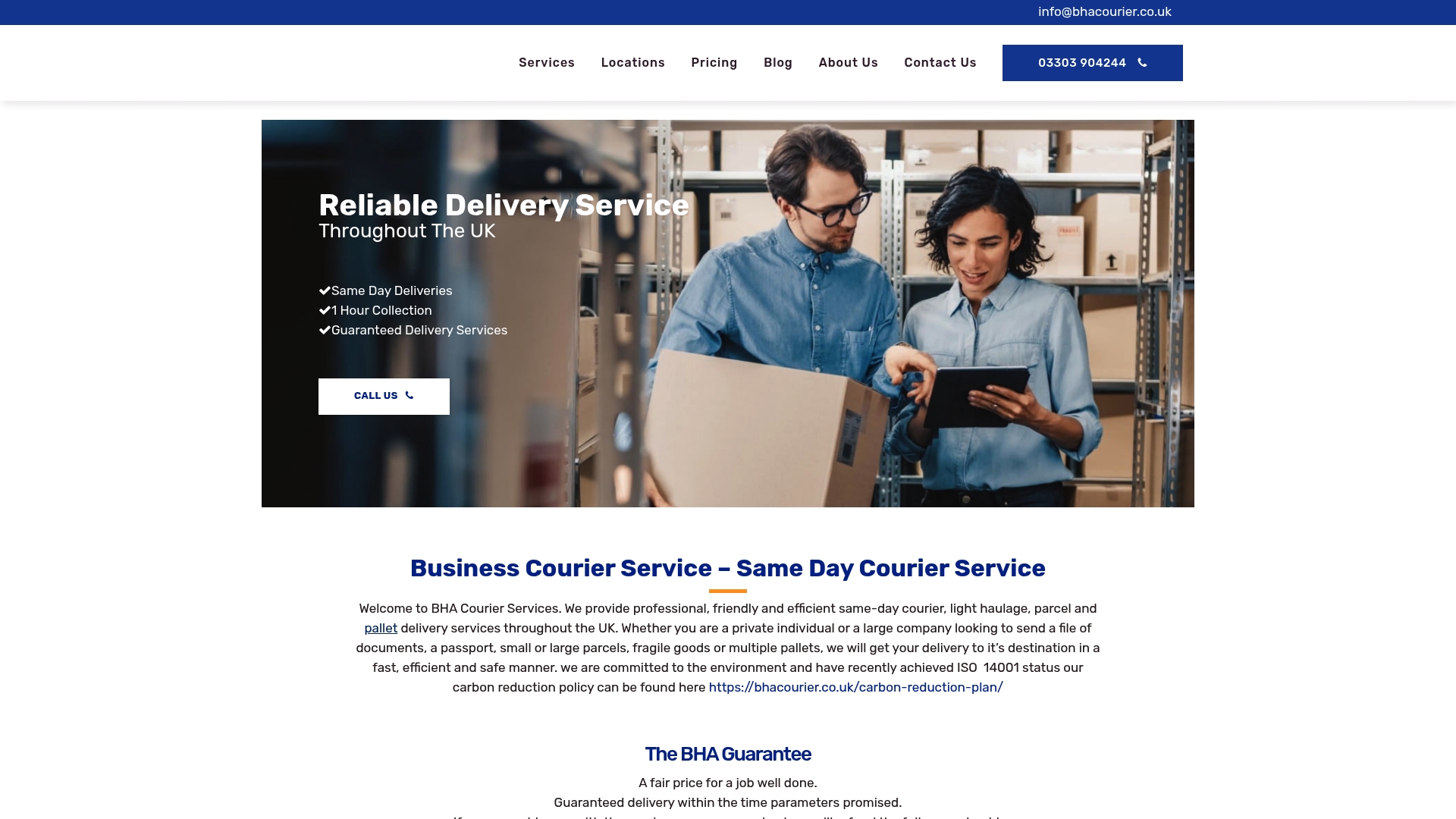
04 Aug Improving Work Life Balance in UK Businesses 2025
Work life balance is climbing the priority list for UK businesses and employees alike, reshaping conversations about job satisfaction and organisational success. Yet despite this shift, around 33 percent of UK employees still deal with persistently high work-related stress each year. Most assume longer hours mean better results, but the true advantage for both staff and business comes from setting boundaries and embracing smarter, more flexible ways of working.
Table of Contents
- Understanding Work Life Balance In The UK
- Practical Steps For Improving Work Life Balance
- Tools And Technology To Support Better Balance
- Improving Work Life Balance For Business Success
Quick Summary
| Takeaway | Explanation |
|---|---|
| Flexible work arrangements boost balance | Implementing flexible hours and remote work enhances employee satisfaction and productivity. Businesses must adapt to support this shift. |
| Clear boundaries are essential | Establishing communication protocols and discouraging after-hours work helps protect personal time and mental health of employees. |
| Tech tools streamline work-life balance | Utilising digital productivity tools and mental health apps facilitates efficient workload management and personal wellbeing. |
| Work-life balance improves business outcomes | Companies focusing on employee wellbeing experience reduced turnover and absenteeism, leading to higher overall performance and engagement. |
| Leadership commitment is critical | Leaders must model balanced behaviours to create a culture that values work-life harmony and boosts employee morale. |

Understanding Work Life Balance in the UK
Work life balance has become a critical focus for UK businesses in recent years, reflecting profound shifts in workplace culture and employee expectations. The concept goes beyond simply dividing time between professional and personal responsibilities, representing a holistic approach to maintaining mental health, productivity, and overall wellbeing.
The Current State of Work Life Balance in the UK
Recent studies reveal significant challenges in achieving optimal work life balance across British workplaces. CIPD Work and Wellbeing Report indicates that approximately 33% of UK employees consistently experience high levels of work related stress, highlighting the urgent need for comprehensive workplace strategies.
The pandemic fundamentally transformed traditional work structures, accelerating flexible working models and remote collaboration. This shift has prompted organisations to reconsider conventional productivity metrics, recognising that employee performance is not solely determined by hours worked but by overall engagement and mental wellness.
Economic and Psychological Implications
Improving work life balance is not merely a humanitarian consideration but a strategic business imperative. Deloitte Research suggests that poor work life balance costs the UK economy approximately £45 billion annually through reduced productivity, increased absenteeism, and higher employee turnover.
Psychological research demonstrates that employees experiencing balanced work environments demonstrate significantly higher job satisfaction, creativity, and organisational commitment. These individuals are more likely to remain with their current employer, reducing recruitment and training expenses while maintaining institutional knowledge.
Key factors influencing work life balance include flexible working arrangements, clear communication boundaries, mental health support, and organisational cultures that genuinely value employee wellbeing. Progressive UK businesses are increasingly implementing comprehensive strategies that address these multifaceted challenges.
The evolution of work life balance represents a fundamental reimagining of workplace dynamics, moving beyond traditional nine to five models towards more adaptive, human centric approaches that recognise individual needs and promote sustainable professional engagement. As we approach 2025, successful organisations will be those that proactively embrace these transformative principles, creating environments where employees can thrive both professionally and personally.
Read our comprehensive guide on workplace wellness strategies to explore innovative approaches for supporting employee wellbeing in modern UK businesses.
Practical Steps for Improving Work Life Balance
Businesses seeking to enhance work life balance must implement strategic and thoughtful approaches that address the complex needs of modern employees. These practical steps require a comprehensive understanding of organisational dynamics and individual employee requirements.
Implementing Flexible Working Arrangements
Flexible working arrangements have emerged as a critical strategy for improving work life balance. ACAS Flexible Working Guidelines recommend implementing policies that allow employees to adjust their working hours, location, and patterns. This might include options such as remote work, compressed workweeks, or flexible start and finish times.
Successful implementation requires clear communication and robust technological infrastructure. Organisations must invest in digital collaboration tools, secure communication platforms, and performance tracking systems that support remote and flexible working models. Managers need training to effectively lead distributed teams, focusing on output and results rather than traditional time based metrics.
Establishing Clear Boundaries and Wellness Support
Creating explicit boundaries between work and personal life is crucial for maintaining employee mental health. Chartered Institute of Personnel and Development suggests organisations should:
- Implement communication protocols that respect personal time
- Discourage after hours email communication
- Provide mental health resources and counselling services
- Develop stress management workshops
- Encourage regular breaks and physical activity during workdays
Proactive wellness programmes demonstrate an organisation’s commitment to employee wellbeing. These initiatives can include fitness memberships, mindfulness training, nutritional counselling, and regular health check ups. By investing in comprehensive support systems, businesses can create environments that prioritise holistic employee wellness.
Technology and Cultural Transformation
Technology plays a pivotal role in enabling work life balance. Advanced digital tools can help employees manage their workload more efficiently, reducing unnecessary stress and creating space for personal activities. Cloud based project management systems, automated scheduling tools, and intelligent workflow platforms can significantly streamline work processes.
Cultural transformation is equally important. Leadership must model balanced behaviour, demonstrating that high performance does not require constant availability. This involves challenging traditional presenteeism culture and recognising that productivity is measured by outcomes rather than hours worked.
Ultimately, improving work life balance requires a nuanced, multifaceted approach. It demands ongoing commitment, regular review of policies, and a genuine organisational dedication to employee wellbeing. As workplace dynamics continue to evolve, businesses that prioritise flexible, human centric approaches will attract and retain top talent.
Learn more about sustainable workplace practices that support employee wellness and organisational success.
Tools and Technology to Support Better Balance
Technology has emerged as a pivotal enabler in supporting work life balance, offering innovative solutions that help employees manage their professional and personal responsibilities more effectively. Modern digital tools are transforming traditional workplace dynamics by providing intelligent, adaptable mechanisms for productivity and personal wellbeing.
Digital Productivity and Time Management Solutions
Gartner’s Workplace Technology Research reveals that organisations implementing advanced digital productivity tools can improve employee efficiency by up to 35%. These technologies range from sophisticated project management platforms to intelligent time tracking applications that help workers understand and optimise their work patterns.
Key technological interventions include:
- Intelligent scheduling tools that automatically block personal time
- Automated workflow management systems
- AI powered task prioritisation applications
- Digital wellness trackers that monitor work intensity and recommend breaks
Advanced platforms like Microsoft Teams and Slack now incorporate built in wellness features, allowing employees to set status indicators that communicate availability, manage notification settings, and create clear boundaries between work and personal time.
Mental Health and Wellness Technology
Psychological wellbeing technologies have significantly advanced in recent years. Mental Health Foundation UK highlights the growing importance of digital mental health support, with applications offering meditation guidance, stress management techniques, and personalised wellness tracking.
These digital solutions provide employees with accessible, confidential support mechanisms. Meditation apps like Headspace and Calm offer corporate programmes that integrate directly into workplace wellness strategies. Cognitive behavioural therapy chatbots and virtual counselling platforms provide immediate, scalable mental health resources that complement traditional support structures.
Communication and Boundary Management Technologies
Effective communication technologies are crucial in maintaining work life balance. Modern platforms enable clear, structured communication that respects personal boundaries. Email scheduling tools allow employees to compose messages during work hours but delay sending until appropriate times, preventing after hours work intrusions.
Advanced communication platforms now include features like:
- Automatic email response systems
- Scheduled communication windows
- Do not disturb modes
- Integrated wellbeing tracking
Artificial intelligence is increasingly being deployed to analyse communication patterns, identifying potential burnout risks and suggesting interventions. These intelligent systems can recommend breaks, suggest workload redistribution, and provide personalised wellness recommendations based on individual work patterns.
As technology continues to evolve, the most effective workplace solutions will seamlessly integrate productivity, communication, and wellness features. Businesses that strategically adopt these technologies will create more supportive, adaptive work environments that genuinely prioritise employee wellbeing.
Explore our guide to sustainable workplace technologies and discover innovative approaches to supporting employee balance and productivity.
To help readers compare the main types of workplace technology mentioned, the following table summarises their features and benefits:
| Technology Category | Key Features | Example Benefits |
|---|---|---|
| Digital Productivity Tools | Scheduling, time tracking, workflow automation | Improved efficiency, better time use |
| Mental Health & Wellness Tech | Meditation apps, virtual counselling, wellness tracking | Accessible support, reduced stress |
| Communication & Boundary Tools | Email scheduling, DND modes, response automation | Clear boundaries, less burnout |
Improving Work Life Balance for Business Success
Achieving work life balance is not just an employee welfare initiative but a strategic imperative for business success in the modern corporate landscape. Companies that effectively integrate balanced workplace practices can unlock significant competitive advantages, driving innovation, productivity, and long term organisational resilience.
Measuring the Economic Impact of Work Life Balance
International Journal of Environmental Research and Public Health research demonstrates that organisations prioritising work life balance experience substantial economic benefits. These include reduced recruitment costs, lower employee turnover, and increased overall productivity.
Key economic indicators reveal that businesses investing in comprehensive work life balance strategies can expect:
- Decreased absenteeism by up to 27%
- Improved employee retention rates
- Enhanced organisational performance
- Higher levels of employee engagement
Financial performance metrics consistently show that companies with robust work life balance programmes outperform competitors who maintain traditional, rigid workplace models. This correlation underscores the critical link between employee wellbeing and organisational success.
The following table provides a summary of important statistics and business outcomes related to work life balance initiatives discussed above:
| Indicator | Reported Outcome |
|---|---|
| UK annual cost of poor work-life balance | £45 billion |
| Reduction in absenteeism | Up to 27% |
| Productivity improvement | Up to 35% (with advanced digital tools) |
| Percentage of UK employees under stress | Approximately 33% |
Strategic Talent Attraction and Retention
Chartered Institute of Personnel and Development research indicates that work life balance has become a primary consideration for top talent when selecting employers. Modern professionals increasingly prioritise workplace flexibility and supportive organisational cultures over traditional compensation packages.
Businesses that successfully implement comprehensive work life balance strategies gain significant competitive advantages in talent acquisition. These organisations attract high calibre professionals who value holistic workplace experiences that support personal and professional growth.
Cultivating a High Performance Culture
Contrary to traditional management perspectives, work life balance does not diminish productivity. Instead, it creates an environment where employees can perform at their highest potential. By removing unnecessary workplace stress and providing supportive frameworks, businesses can unlock unprecedented levels of creativity, innovation, and discretionary effort.
Leadership plays a crucial role in this transformation. Executives must model balanced behaviour, demonstrating that high performance emerges from strategic work management rather than continuous overwork. This cultural shift requires ongoing commitment, regular policy reviews, and a genuine organisational dedication to employee wellness.
As workplace dynamics continue to evolve, businesses that embrace flexible, human centric approaches will distinguish themselves in increasingly competitive markets. Work life balance is no longer a peripheral HR consideration but a fundamental strategic differentiator that directly impacts organisational success.
Discover our comprehensive guide to sustainable workplace strategies and learn how to transform your organisational culture for enhanced performance and employee satisfaction.

Frequently Asked Questions
What is work life balance and why is it important for UK businesses?
Work life balance refers to the ability to manage professional and personal responsibilities, promoting overall wellbeing and mental health. It’s essential for UK businesses as it leads to higher job satisfaction, better productivity, and reduced employee turnover.
How can UK businesses implement flexible working arrangements?
UK businesses can implement flexible working arrangements by allowing employees to adjust their working hours, locations, and patterns. This may include options such as remote working, flexitime, or compressed workweeks, supported by the right technology and communication strategies.
What role does technology play in improving work life balance?
Technology plays a crucial role in enhancing work life balance by offering tools for digital productivity, time management, and wellness tracking. Solutions like project management platforms, scheduling tools, and mental health apps can help streamline tasks and reduce work-related stress.
How does work life balance impact employee retention in UK businesses?
A strong work life balance significantly improves employee retention as it meets the growing demand for flexibility and support from modern professionals. Businesses that prioritise employee wellbeing are more likely to attract and retain top talent, ultimately enhancing their organisational success.
Unlock Work Life Balance With the Right Courier Partner
For businesses aiming to reduce stress and reclaim work life balance, delivery disruptions and last-minute logistics are major sources of frustration. The article highlighted how high-pressure deadlines, unclear boundaries, and unpredictable workloads undermine employee wellbeing. If your team is constantly stretched managing time-critical parcels or secure document transport, it can undo even the most flexible work policies.

Let your people focus on their strengths and trusted routines. With BHA Courier’s reliable same-day and next-day services, you gain peace of mind knowing urgent packages will arrive safely and on time every time. Our straightforward booking and tracking give you control and clarity, freeing your team to focus on what matters. Visit our main site today to find out how we keep your business running smoothly, supporting a healthier work life balance for everyone involved.
Recommended
- Best Business Sustainability Practices for UK Success 2025 – BHA Couriers
- Green Logistics Strategies for UK Businesses in 2025 – BHA Couriers
- New Trends in Logistics: What UK Businesses Need to Know in 2025 – BHA Couriers
- Consolidated Shipments for UK Businesses: Benefits and 2025 Guide – BHA Couriers

Sorry, the comment form is closed at this time.